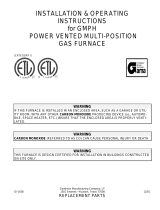
8
MAXIMUM DIRECT VENT, DUAL PIPE LENGTH (FT.)
M7RL INPUTS
(BTU)
INLET / OUTLET
2” DIAMETER
INLET / OUTLET
3” DIAMETER
45,000 30 60
60,000 30 60
72,000 30 60
†
NOTES:
1. Subtract2.5ft.foreachadditional2inchlongradiuselbow,subtract
5ftforeachadditional2”shortradiiouselbow,subtract3.5ft.foreach
additional3inchlongradiuselbow,and7ft.foreachadditional3
inchshortradiuselbow.
2. Two45degreeelbowsareequivalenttoone90degreeelbow.
3. Thistableappliesforelevationsfromsealevelto2,000ft.Forhigher
elevations,decreasepipelengthsby8%per1,000ftofaltitude.
Table 2. Vent Pipe Lengths
• In the absence of local codes, the location of any
combustionairinletrelativetoanyventterminalmust
beatleast8inches.Thisincludesinstallationsinvolving
morethanonefurnace.
• Thequalityofoutdoorairmustalsobeconsidered.Be
surethatthecombustionairintakeisnotlocatednear
a source of solvent fumes or other chemicals which
cancausecorrosionofthefurnacecombustionsystem.
(Seepage5forasamplelistofsubstances).
• Routepipingasdirectaspossiblebetweenthefurnace
and the outdoors. Longer vent runs require larger
diameters.Ventpipingmustbeslopedupwards1/4”
perfootinthedirectionfromthefurnacetotheterminal.
This ensures that any condensate ows back to the
condensatedisposalsystem.
• When a 2-pipe system is used, the combustion air
intake and the vent exhaust must be located in the
same atmospheric pressure zone. This means both
pipesmustexitthebuildingthroughthesameportion
ofexteriorwallorroofasshowninFigure1,Figure2
&Figure4(page9)andFigure29(page38).
• Pipingmustbemechanicallysupportedsothatitsweight
doesnotbearonthefurnace.Pipesupportsmustbe
installedaminimumofeveryvefeetalongtheventrunto
ensurenodisplacementafterinstallation.Supportsmay
beatshorterintervalsifnecessarytoensurethatthere
arenosaggingsectionsthatcantrapcondensate.Itis
recommendedtoinstallcouplings(Figure29)alongthe
ventpipe,oneithersideoftheexteriorwall.Couplings
mayberequiredbylocalcode.
• Ifbreakableconnectionsarerequiredinthecombustion
airinletpipe(ifpresent)andexhaustventpiping,then
straight neoprene couplings for 3” piping with hose
clampscanbeused.Thesecouplingscanbeordered
through your local furnace distributor. To install a
coupling:
1. Slidetherubbercouplingovertheendofthepipe
thatisattachedtothefurnaceandsecureitwithone
ofthehoseclamps.
2. Slidetheotherendoftherubbercouplingontothe
otherpipefromthevent.
3. Securethecouplingwiththesecondhoseclamp,
ensuringthattheconnectionistightandleakfree.
OutdoorTerminations-HorizontalVenting
• Ventandcombustionairintaketerminationsshallbe
installedasshown inFigure1,Figure 2,Figure3,&
Figure4andinaccordancewiththeseinstructions:
• Ventterminationclearancesmustbeconsistentwiththe
NFGC,ANSI2223.1/NFPA54and/ortheCSAB149.1,
NaturalGasandPropaneInstallationCode.Table14,
(page37)liststhenecessarydistancesfromthevent
terminationtowindowsandbuildingairintakes.
• Vent and combustion air intake terminations must
be located to ensure proper furnace operation and
conformance to applicable codes. A vent terminal
mustbelocatedat least3feetaboveanyforcedair
inletlocatedwithin10feet.Thisdoesnotapplytothe
combustionairinletofadirectvent(twopipe)appliance.
InCanada,CSAB149.1takesprecedenceoverthese
instructions.SeeTable14.
Condensingfurnacecombustionproductshaveverylittle
buoyancy,soTable2istobeusedwithoutconsideration
ofanyverticalriseinthepiping.
VentPipeMaterial
Ventandcombustionairpipeandttingsmustbeone
ofthefollowingmaterialsinthelistandmustconformto
theindicatedANSI/ASTMstandards.
MATERIALS STANDARDS
SCHEDULE40PVC................................................... D1785
PVC-DWV.................................................................. D2665
SDR-21&SDR-26..................................................... D2241
ABS-DWV.................................................................. D2661
SCHEDULE40ABS....................................................F628
FOAM/CELLULARCOREPVC.................................F891
*POLYPRO
®
BYDURAVENT................................. ULC-S636
*WhenusingPolyPro
®
,allventingandttingsmustbefromthesame
manufacturerwithnointerchangingofothermaterials.Refertospecic
instructionssuppliedwiththePolyProventkits.
WhenjoiningPVCtoPVC,usecementthatconformsto
ASTMstandardD2564.PVCprimermustmeetstandard
ASTMF656.WhenjoiningABStoABS,usecementthat
conformstoASTMstandardD2235.WhenjoiningPVCto
ABS,usecementasspeciedinprocedurefromASTM
standardD3138
In Canada, all plastic vent pipes and ttings including
anycement,cleaners,orprimersmustbecertiedasa
systemtoULCS636.Howeverthisrequirementdoesnot
applytothenishangesorpipinginternaltothefurnace.
VentPipeInstallation
CAUTION:
Combustion air must not be drawn from a
corrosive atmosphere.
Thisfurnacehasbeencertiedforinstallationwithzero
clearancebetweenventpipingandcombustiblesurfaces.
However,itisgoodpracticetoallowspaceforconvenience
ininstallationandservice.




















